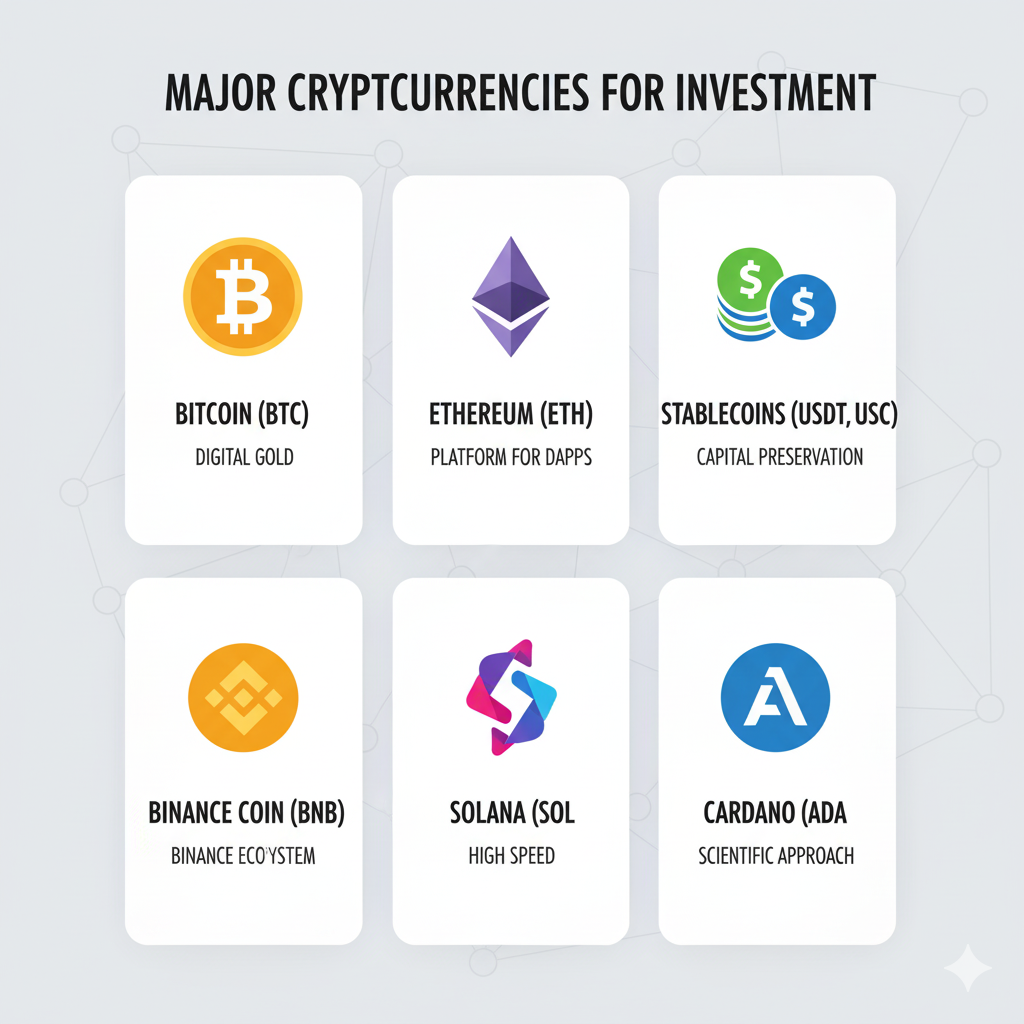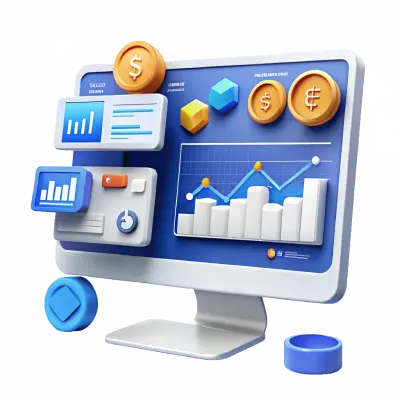Crypto Trading for Beginners: A Complete Guide to Trading Cryptocurrency

Crypto Trading for Beginners: A Complete Guide to Trading Cryptocurrency
Crypto trading is the practice of trading cryptocurrencies to profit from price differences. Essentially, it's simple: buy low, sell high. But unlike the stock market, where trades only happen during the exchange's business hours, the crypto market is open 24/7. For traders, this is a huge plus: you can enter a trade at any moment. However, there's a downside—prices change very quickly, and along with the chance for good profits, the risks also increase.
You can trade cryptocurrencies on special platforms called crypto exchanges. The most popular ones include Binance, Coinbase, and Kraken. They provide access to hundreds of coins and various tools, from simple buying and selling to trading futures and options. For instance, you can exchange Bitcoin for Ethereum, or you can trade using stablecoins like USDT. To better understand the market, many use technical analysis, which helps predict price movements using charts and indicators.
The history of crypto trading began in 2009 with the appearance of the first Bitcoin. Back then, no one imagined that in just a few years, the market would grow to thousands of different coins and attract interest not only from individual traders but also from large investment firms.
The main difference between cryptocurrencies and traditional assets is that the market is decentralized. There is no central authority or bank managing the process. On one hand, this provides freedom—anyone from anywhere in the world can trade. On the other hand, it introduces risk: fraudulent projects exist, and some exchanges don't always reliably protect user funds.

Ultimately, crypto trading is an opportunity to earn, but also a challenge for those who decide to dive in. It requires not just money, but also knowledge, the ability to analyze the market, and keeping emotions in check.
What You Need to Know to Become a Crypto Trader
Becoming a successful crypto trader is impossible without foundational knowledge and practical skills. Here are the key points for beginners to focus on:
-
Understanding Cryptocurrency Basics. Before trading, it's crucial to understand how blockchain and cryptography work, the differences between mining and staking, and the Proof-of-Work and Proof-of-Stake mechanisms. This knowledge will help you soberly assess the prospects of different projects and avoid falling for hype.
-
Mastering Technical Analysis. Charts and indicators are tools that are hard to imagine trading without. Master candlestick patterns, support and resistance levels, and popular indicators like RSI and MACD. They will help you better understand where the market might be headed.
-
Working with Exchanges. Beginners should start with trusted platforms like Binance, Bybit, and Kraken. They have user-friendly interfaces and educational materials. You need to learn how to place limit and market orders, use stop-losses, and understand how margin trading works.
-
Risk Management. You won't last long in crypto without risk management. It's important to limit losses, diversify your portfolio, and use stop-orders to protect yourself from sharp price movements.
-
Following the News. The cryptocurrency market is very sensitive to news. Statements from regulators, the launch of new blockchains, or news from major companies can instantly reverse a trend. Therefore, it's important to stay informed and react quickly.
-
Practice and Discipline. It's best to start with small amounts or even demo accounts. Mistakes are inevitable, but analyzing your actions is what forms a working strategy. A trader's greatest allies are discipline and the ability to control emotions.
-
The Legal Side. Different countries regulate cryptocurrencies differently: some impose taxes, while others ban them completely. To avoid problems, you should study the laws of your jurisdiction in advance.
-
Additional Tips.
-
Don't overuse leverage—it increases both profit and risk.
-
Store your funds in cold wallets if you don't plan on active trading to protect your assets from hacks.
Risks in Cryptocurrency Trading
Trading digital assets opens up great opportunities, but it also carries serious risks. To avoid losing capital, it's important to understand in advance what threats every trader faces.
-
High Volatility. Cryptocurrencies can sharply rise or fall in price within minutes. This offers a chance for quick earnings but can also lead to significant losses.
-
Lack of Regulation. The cryptocurrency market in many countries remains partially or completely unregulated. Because of this, traders are less protected than in traditional financial markets.
-
Risk of Losing Funds on an Exchange. Even major crypto exchanges are vulnerable to hacks or technical failures. In the event of an attack or bankruptcy of the platform, it may be impossible to recover your money.
-
Trader Errors. Incorrect calculations, emotional decisions, "all or nothing" trading, and the misuse of leverage often become the cause of losses.
-
Market Manipulation. Since the market is still young and relatively small in volume, prices are easily susceptible to manipulation by large players ("whales").
-
Legal and Tax Risks. In some countries, cryptocurrencies are banned, while in others, strict tax rules apply. Inattention to these issues can result in fines.
-
Phishing and Scams. Scammers use fake websites, emails, and even mobile apps to steal data. Securely storing your keys and working only with official resources is a must.
-
Loss of Access to a Wallet. A forgotten seed phrase or a lost private key means the complete and irreversible loss of assets.
Main Types of Cryptocurrency Trading
Day Trading
Day trading involves opening and closing trades within a single day. The point of the strategy is to catch short price fluctuations and profit from them. To find the best entry and exit points, traders actively use charts, indicators, and technical analysis methods. The main advantage of this approach is the absence of "overnight risks": all positions are closed by the end of the day. But this style requires full engagement—you need to constantly monitor the market and react quickly to changes.
Scalping
Scalping is a strategy for those who love dynamics. Trades here last only seconds or minutes, and earnings are built on a multitude of small price movements. Scalpers prefer highly liquid assets like Bitcoin and Ethereum to quickly enter and exit positions. They often use special software that allows for instant order execution. This approach can be profitable but requires maximum concentration and stress resistance.
Other Strategies
-
Swing Trading. Trades are held from several days to weeks. It's suitable for those who are not ready to sit in front of charts all day but want to profit from medium-term trends.
-
Arbitrage. The essence is to buy an asset cheaper on one exchange and sell it for more on another. Speed and accounting for fees are crucial here.
-
Long-Term Investing. An investor buys a cryptocurrency and holds it for months or years, counting on a global increase in its value.
Blockchain and Crypto Trading: What's the Connection?
Blockchain is the technology on which cryptocurrencies are based. It provides transparency, security, and decentralization. All transactions are recorded in a single chain of blocks, which eliminates the possibility of forgery or fraud. For traders, this means the market is transparent: you can track the history of trades and be confident in the system's integrity. Moreover, blockchain opens the way for automation. Smart contracts on platforms like Ethereum allow for the execution of algorithms that complete trades when specified conditions are met. This is especially useful in arbitrage and high-frequency strategies. Knowledge of blockchain basics gives traders an additional advantage—it helps to assess the prospects of projects and avoid fraudulent schemes.
What Is Traded on the Cryptocurrency Market?
On the cryptocurrency market, digital assets are traded. These are:
-
Cryptocurrencies — Bitcoin, Ethereum, and thousands of altcoins.
-
Stablecoins (USDT, USDC, DAI) — pegged to the dollar or other currencies.
-
Project Tokens — coins of DeFi platforms, gaming, and NFT ecosystems.
-
Derivatives — futures, options, contracts with leverage.
-
NFTs — non-fungible tokens, more often as an investment or collectible asset.
Thus, traders work not only with the coins themselves but also with derivative instruments that allow earning on both the rise and fall of the market.
Common Mistakes of Beginner Traders
In crypto day trading, beginners often make the same mistakes. Among them are an excessive number of trades without a pre-planned strategy, trying to trade in illiquid markets or during a sideways trend, and opening positions that are too large without setting stop-losses. Another problem is focusing only on quick wins. Instead of building a sustainable strategy, beginners concentrate on small, short-term victories, which ultimately leads to losses. It's worth remembering: even professionals lose money. But the difference with experienced traders is that they know how to control risks and strictly follow their system. For most beginners, the main enemy is not the market, but their own emotions and lack of discipline.
Which Cryptocurrencies Are Best to Invest In?

Those who are just beginning to understand crypto investments should focus on large and proven projects. They have a transparent ecosystem, high liquidity, and lower risk compared to lesser-known tokens. For beginners, the following options would be optimal:
-
Bitcoin (BTC). Bitcoin is the foundation of any crypto portfolio. Its limited emission (21 million coins), over 15 years of flawless network operation, and huge liquidity make it the most reliable asset. BTC traditionally remains stable during crisis periods.
-
Ethereum (ETH). The second-largest coin by capitalization and the leading platform for smart contracts. A whole ecosystem of DeFi and dApps has been built on Ethereum. The transition to Proof-of-Stake has made it possible to earn income from staking, which makes ETH interesting for long-term investors.
-
Stablecoins (USDT, USDC). An excellent tool for beginners. Stablecoins help preserve capital during high volatility and allow for quick reactions to new market opportunities.
-
Binance Coin (BNB). The token of the largest crypto exchange, Binance. It is used to pay for commissions, participate in IEOs, and other services of the ecosystem. Binance regularly buys back and burns a portion of the coins, which supports the growth of BNB's value.
-
Solana (SOL). A high-performance blockchain with low fees. After resolving technical issues, Solana began to grow actively, and its ecosystem is attracting more and more developers and projects.
-
Cardano (ADA). A blockchain that is developing based on a scientific approach and rigorous checks. ADA has a strong community and a long-term roadmap. A good option for portfolio diversification.
Conclusion
Day trading cryptocurrency offers great opportunities for earnings but requires discipline, knowledge, and strict risk management. Success here depends not only on the chosen strategy but also on the ability to control emotions and stick to a plan. Beginners should start with small amounts or a demo account, gradually accumulating experience. Remember: the market always remains volatile and unpredictable, so a trader's main weapon is discipline, not luck.
FAQ
-
What is cryptocurrency day trading? It's a strategy where a trader buys and sells cryptocurrencies within a single day to profit from short-term price fluctuations.
-
How does day trading differ from long-term investing (HODL)? HODL is holding coins for months or years for future growth. Day trading focuses on quick, intraday trades for small profits.
-
What tools do day traders use? Technical analysis: candlestick charts, moving averages, RSI, MACD, and support and resistance levels.
-
Which cryptocurrencies are best to work with? Highly liquid assets: Bitcoin (BTC), Ethereum (ETH), and popular altcoins where it's easy to open and close a position.
-
What are the main risks of day trading? High volatility, emotional pressure, lack of a clear plan, trading without stop-losses, and making an excessive number of trades.
-
Can beginners engage in day trading? Yes, but it's better to start with a demo account or small amounts until experience and discipline are developed.
-
What are the most common mistakes beginners make? Opening positions that are too large, trading on low volumes, chasing quick profits, and forgetting about risk management.
-
What strategies are suitable for intraday trading? Using VWAP, moving averages, RSI, support/resistance levels, and trading along trend lines.
-
What is needed for a successful start? A reliable exchange with low fees, a trading plan, strict discipline, risk management, and continuous learning.
Want to learn more about crypto arbitrage?
Get a subscription and access the best tool on the market for arbitrage on Spot, Futures, CEX, and DEX exchanges.






